 Because of the remarkable intelligence of insects with tiny brains, such as bees, ants and termites, many ascribe their capabilities to the hive or colony. In fact, there is increasing evidence that individual ants, bees, and termites are very intelligent, which allows for intelligent actions of the colony. In the case of humans, the fact that the Internet is becoming a form of super-organism does not mean that individual humans are not intelligent themselves. A previous post outlined the overwhelming evidence for individual bee intelligence and the structure of their remarkable tiny brain. It is quite different from the human brain, but with some similar neurons. Bees and ants even demonstrate some capabilities that are superior to humans. This post will describe recent dramatic research for the ant intelligence update.
Because of the remarkable intelligence of insects with tiny brains, such as bees, ants and termites, many ascribe their capabilities to the hive or colony. In fact, there is increasing evidence that individual ants, bees, and termites are very intelligent, which allows for intelligent actions of the colony. In the case of humans, the fact that the Internet is becoming a form of super-organism does not mean that individual humans are not intelligent themselves. A previous post outlined the overwhelming evidence for individual bee intelligence and the structure of their remarkable tiny brain. It is quite different from the human brain, but with some similar neurons. Bees and ants even demonstrate some capabilities that are superior to humans. This post will describe recent dramatic research for the ant intelligence update.
The individual Ant
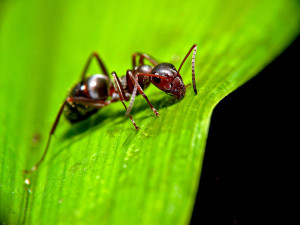 Ants navigate long distances, find food, communicate and avoid predators. They care for their family similar to any mammal. When finding a new home, ants take advice from their more experienced brethren who had memorized alterative hive locations. When enough ants visit the new space and decide that they like it, the colony decides to move. Ants are led by the smartest of the group, not by a mysterious “hive intelligence.” Ants are altruistic and spend hours trying to help a comrade who is stuck, at great risk to themselves. Ants integrate many types of information for navigation—the number of steps, direction travelled, wind, land type, angles of the sun, visual memories of landmarks and smells. Individual ants use diverse information in different situations and can learn entirely new ways to navigate.
Ants navigate long distances, find food, communicate and avoid predators. They care for their family similar to any mammal. When finding a new home, ants take advice from their more experienced brethren who had memorized alterative hive locations. When enough ants visit the new space and decide that they like it, the colony decides to move. Ants are led by the smartest of the group, not by a mysterious “hive intelligence.” Ants are altruistic and spend hours trying to help a comrade who is stuck, at great risk to themselves. Ants integrate many types of information for navigation—the number of steps, direction travelled, wind, land type, angles of the sun, visual memories of landmarks and smells. Individual ants use diverse information in different situations and can learn entirely new ways to navigate.
Ants respond immediately to new situations. They can adjust to different levels of threat and decide how aggressive they should be and how much energy should be used. When the nest is damaged, immediately large numbers of ants will work to fix it. Ants understand the new problem and what has to be done. They gather the material needed to fix it.
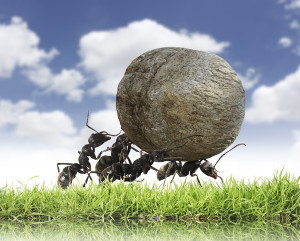 Ants cooperate to take items that are too large for one ant. Ants can connect multiple sites in the shortest possible way and produce this result by making many trails and then eliminating all but the most efficient path. Ant paths are formed by their leaving smells called pheromones, which take personal effort.
Ants cooperate to take items that are too large for one ant. Ants can connect multiple sites in the shortest possible way and produce this result by making many trails and then eliminating all but the most efficient path. Ant paths are formed by their leaving smells called pheromones, which take personal effort.
Ants use multiple antibiotics in their farming of fungus for food. They inoculate the hive for mild illness (vaccinate) and isolate themselves voluntarily for serious illness.
For a comparison, the next section will briefly describe bee and termite intelligence. After that more details about ant intelligence will be presented.
Bees and Termites
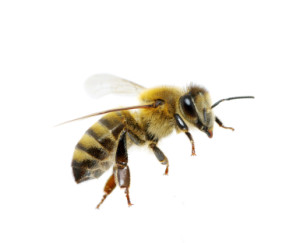 A previous post reviewed termites engineering abilities, which are far beyond those of humans. Their structure is equivalent to a human skyscraper filled with such advanced refrigeration and air quality control that humans couldn’t possibly build it. If it is damaged, they appear immediately with guards and rebuild the damaged section.
A previous post reviewed termites engineering abilities, which are far beyond those of humans. Their structure is equivalent to a human skyscraper filled with such advanced refrigeration and air quality control that humans couldn’t possibly build it. If it is damaged, they appear immediately with guards and rebuild the damaged section.
Another post described the remarkable bee brain. Bees forage for information. With a very tiny brain, individual bees are able to use abstract concepts (above/below and difference), sequences, combinations, and symbolic language and have a kaleidoscopic memory for miles of detailed scenery. This memory includes individual flowers and detailed locations, such as their relationship to the sun. They can remember exactly where a better hive could be built and can describe it to their comrades. Bees are able to solve the very advanced mathematical problem called the “Travelling Salesman Problem”—finding efficient routes between many different stops. Bees are able to also include the quality of the flowers at the stop as well as the routes. They do not copy other bees who make bad choices of flowers. Also, bees understand future rewards.
In addition, bees self medicate their hives, understanding where medicines are, how to mix them, and specifically when to apply them (with specific fungal infections in the hive). They are able to build a honeycomb—a remarkable feat of engineering, which is the most efficient and the strongest way to store honey that has been conceived by human scientists. They use advanced physics with the wax flowing at a specific temperature, the surface tension stretching the wax, then fusing with other walls to form a perfect hexagon.
When bees learn symbols for sugar or bad tasting liquid, they choose correctly if the symbols are quite distinct (circle and square). If the symbols are ambivalent (circle and oval) they waited and slowly chose the correct choice.
Ant Perception
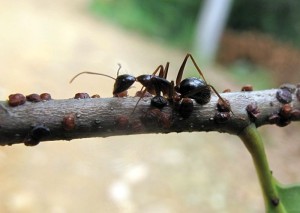
As well as smell, ants use vision for navigation, and now are noted to use sound. They make a sound by stroking along their abdomen with a hind leg. This sound is used to announce emergencies such as approach of a predator. Those pupae, or children, who make sounds, are rescued first.
Perhaps, the major form of ant perception and communication is smell, by using pheromones. Using these smells, ants can determine which colony an ant is from and its status in that colony. Ants have 400 distinct smell receptors. Other insects have less—silk moths with 52, fruit flies 61, mosquitoes 74 to 158 and bees 174.
In normal colony life, ants produce many smells and coat their bodies with 40 to 50 compounds. Ants can distinguish these fifty smells and use them to categorize others they meet.
Each nest produces a large number of these compounds with unique smells and each nest has a signature based on a particular blend of these many odors. When an ant meets another, it evaluates the pattern of smells and identifies those from its own nest versus strangers.
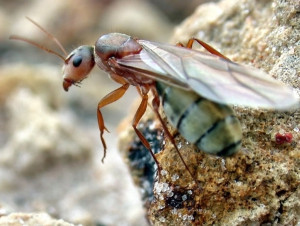
Only queens are allowed to use one particular smell, called nonacosene, a sign of fertility among all ant species. If an ant that is not the queen dares to use this scent, the community punishes her.
When ants meet a queen in a show of respect they retract their antennae, crouch and back off as if meeting a human queen. But, when meeting a queen from another hive they do not retract their antennae. They did retract with queens from other nests of their same colony. Therefore, the ants first recognized their group, and didn’t respect the queen from another colony.
Some colonies have multiple queens with different genes. These complex hives use the same chemical signals as single queen colonies. Some species have both single queen and multiple queen colonies. Even with different genes the same signals and smells prevailed with no difference in their behavior. So, this behavior is cultural and not based on genetics.
Navigation and Learning
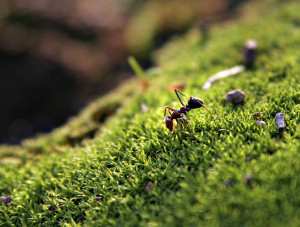
Ants’ navigation skills are quite sophisticated. The usual navigation of the individual ant is often called path integration because they use many sources of information and combine them in different ways. They use the position of the sun (like bees), visual memory of objects and panoramas, wind directions, the texture of the ground and the slope of the land. They count their steps and remember the direction and angle to find a new object and return to the hive. They use polarized light patterns. They, also, use odors over distances. They use different techniques at different times.
Individual ants were trained to use magnetic and vibrational landmarks. They then used this totally new modality to find their nest, showing their great learning ability.
In another experiment, ants were placed at distances from their nests and they rapidly found the nest using visual memory of the area. This is different than their more frequent use of measured steps and memory of the direction. When they only had visual pictures they actually found the nest more rapidly because they weren’t calculating the steps and angles. They did this best in daylight not the dark. When totally lost, they tried to use path integration techniques and then switched to searching where they turn to the left in circles.
They keep track of how far they have travelled and are aware of how long it will take to get back to the nest. Ants understand when they don’t know where they are and start systematic exploration to return to the nest.
Ant Decision Making
Ants make many different intelligent decisions. Ants use the division of labor, quorums, positive feedback and communication to make a decision. One decision is the level of threat of a predator. A low level threat will trigger dragging of the enemy. For severe threat they bite and sting intruders.
Finding New Nests
 There is some similarity between bees and ants in how they make decisions. When bees dance twice as long for a direction with twice the amount of food, more bees are exposed to that particular source and go to it to find out. They return and also dance twice as long contacting a larger and larger number of bees.
There is some similarity between bees and ants in how they make decisions. When bees dance twice as long for a direction with twice the amount of food, more bees are exposed to that particular source and go to it to find out. They return and also dance twice as long contacting a larger and larger number of bees.
Individual ants have opinions on whether a new site is better or not. Ants look for the darkest interior for a new home. Upon finding a good spot, an ant returns very quickly and brings another ant to see it. Then they return with larger and larger numbers to see the chosen site. Older knowledgeable worker ants were more important in identifying the nest and transporting the colony to the nest. Younger workers learned in this process but were not instrumental.
Ants that have previously gone to an inferior site can change their mind and go to the better site. When enough ants are going to the new site, they determine that this is the place and everyone comes and they often carry the queen.
When the nest is destroyed in an experiment, individual ants went to previous possible nests they had already identified. They had previously memorized where these were and went very quickly to them. Others used random circling to find one. When they find a suitable place they returned to the nest and brought others to these sites.
Searching for food
 When foraging for food, ants circle around the nest and when tired return to rest and eat. If an ant finds some food in their initial search, she takes it back to the nest leaving a scent trail to the food. Comrades then follow the scent trail, which is weak at first. When others find it they strengthen the scent trail. The trail becomes clearer and many others can go directly to the food leaving a better and better trail.
When foraging for food, ants circle around the nest and when tired return to rest and eat. If an ant finds some food in their initial search, she takes it back to the nest leaving a scent trail to the food. Comrades then follow the scent trail, which is weak at first. When others find it they strengthen the scent trail. The trail becomes clearer and many others can go directly to the food leaving a better and better trail.
Older ants, understanding the regions around the nest, are better at finding food and they find most of it. The younger ants practice foraging and eventually learn how to do it better. The nest relies on the older individual ants experience in finding food and then magnifies the effect by teaching the younger ants as well as having groups following to the food.
The amount of individual foraging is based on the amount of food at the nest and the quality of the neighborhood’s food supply. They signal each other with different rates of antennae contacts to note the different levels of need.
Kindness and Altruism
 Ants spend considerable energy digging out trapped comrades, pulling at their limbs. This task is quite dangerous for the rescuer, who can also be trapped or captured by predators.
Ants spend considerable energy digging out trapped comrades, pulling at their limbs. This task is quite dangerous for the rescuer, who can also be trapped or captured by predators.
In a research experiment ants were trapped by glue and pincers and covered with sand near an ants’ nest. The trapped ants produced a smell of distress. While the ants in the nest use sand digging and pulling of limbs to rescue comrades in the wild, in this artificial situation they created other ways to do it. They moved sand away using many trips until and they exposed the trap.
Then they bit open the trap and tugged at threads used for the trap. They were quite inventive in their rescue since they had not encountered this particular trap. Some of the rescues took hours, where the ant rested for a while and continued to struggle to free the captured ant. Ants, also, rescued those that were unconscious, not just in distress.
The most altruistic ants were those that spent a lot of time by themselves in sand and were at risk of multiple predators.
Personality Differences
Ants, bees and cockroaches have been shown to have individual personality differences. Like humans, some ants communicate with a few others, while some are very connected in a wide circle. The average is about 40 different connections. Ten percent had more than a 100.
Left Bias
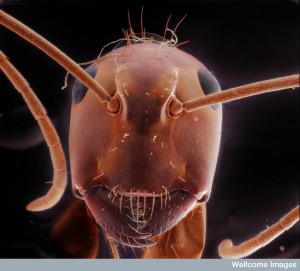 Ants usually turn to the left when searching new spaces. They also tend to follow walls. This seems to be related to using their right eye to navigate, which makes them turn left watching the new space. They use their left eye to watch out for predators. Going in this one direction routinely allows them to methodically search out new spaces. It, also, helps ants to see their comrades while searching.
Ants usually turn to the left when searching new spaces. They also tend to follow walls. This seems to be related to using their right eye to navigate, which makes them turn left watching the new space. They use their left eye to watch out for predators. Going in this one direction routinely allows them to methodically search out new spaces. It, also, helps ants to see their comrades while searching.
Humans, also, lateralize with left or right-handedness.
Farming and Cultivating Crops
Ants play critical roles for some plants. They provide soil aeration, cycle nutrients such as nitrogen and disperse seeds. They increased pitchers’ capture efficiency by keeping traps clean, and also protected the plants by actively hunting mosquito larvae that otherwise bred in pitcher fluids and sucked up plant nutrients.
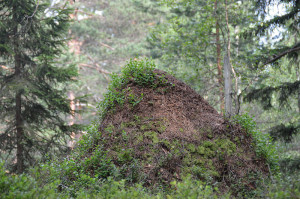
Humans and ants are the only creatures that farm and cultivate plants. Ants started farming 50 million years ago when they had only small farms. They learned cultivation about 20 million years ago and now have large commercial farms, 100,000 times larger.
One key for production is high quality leaves. Another is cultivation techniques. Eventually, the ants became completely dependent on their cultivated crop.Ants collect leaves to use to grow fungus. They fertilize it with their dung. Over time they have gradually improved their farming. Because fungus provides specific nutrients the ants stopped making these themselves. Ants use amino acids and enzymes from the fungus to alter the leafy material they gather, which allows the fungus to grow many more nutrients including lipids, carbohydrates, amino acids and enzymes.
Fungus evolved special food organs for the farmers. These specialized organs provide many of the needed foods for the ants. Ants, also, use multiple different antibiotics from bacteria to kill weeds and support their fungus farms, making them safe as food for their queen and larvae.
Ant Doctors – Vaccination and Isolation
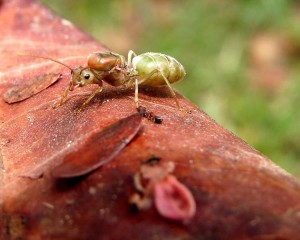
Ants use hygienic and immune practices in different ways. They can distinguish between mild and serious illness. When an ant is mildly ill, others lick them to clean off spores, but, also, to spread the low level infection throughout the colony in order for all members of the colony to develop immunity (vaccination).
When an ant is very ill, it voluntarily leaves the nest hours or days before death, rather than infect the others with a serious illness. In this voluntary practice, ants travel quite far away from the nest. Bees, also, leave the hive when infected by fly larvae, but this is to make the larvae cold and kill it.
Individual Ants and Control of the Ant Society

Ants maintain social order in a variety of ways. Recently, ants were noted to punish those who attempt to try to reproduce usurping the queen’s role. When workers try to have their own children they produce smell smells. They drag these outside, bite and sting them to death.
It is the social interactions and individual differences among ants that determine the colony properties, which are quite variable. Larger colonies have more specialization of work. The workers are divided into different groups to perform very specific jobs. In different shaped nests they use different behavior
Society — Saving Queen with Raft
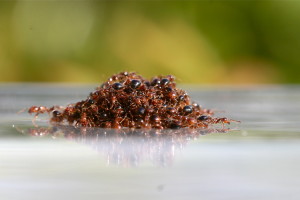 Ants clearly act as individuals and exhibit leadership. But, groups of ants can do remarkable feats together such as the fire ant raft.
Ants clearly act as individuals and exhibit leadership. But, groups of ants can do remarkable feats together such as the fire ant raft.
When facing a flood the ant colony builds a raft and surrounds the queen in the middle of the raft. Worker ants and the youngest are more buoyant. The ants placed the youngest and the workers on the bottom of the raft to keep it afloat and still survived.
In experiments, when fire ants are thrown into water, they quickly use their claws and jaws to grip the feet of other ants, forming a woven lattice of bodies that is completely water-resistant: a living raft. Despite the tightness of the fit, the ants’ position in the rafts allows each one to breath with trapped air. These rafts, which can remain intact for long periods of time, allow the ants to safely traverse water or escape floods.
Ant Intelligence Update
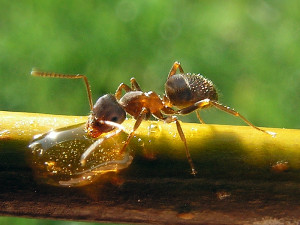
Individual ants show a remarkable range of intelligent behaviors. They can learn entirely new ways to navigate and add it to their large number of techniques, which include counting steps, remembering angles, direction and visual scenes, noting the angle of the sun and using polarized light. They use a large language of smells as well as sounds and sights. Ants are altruistic and spend considerable energy saving trapped comrades, even at their own expense. Ants learn from the smarter more experienced elders, who excel at finding food and new nests. Ants developed complex farming millions of years before humans and now use antibiotics, weed killers and nutrients to cultivate their crops. Ants, also, use vaccination and isolation techniques for different levels of illness.
While there are ways ants pass on information to each other and work together to perform complex tasks, there is no self organizing principle nor distributed computer functioning as some would like to think. Having an Internet doesn’t diminish individual human intelligence. The type of approach searching only for “hive intelligence” minimizes understanding the advanced intelligence of individual ants and bees.
We have just begun to understand different animal intelligences. Ants and bees have tiny brains, which are different from humans; they have some small groups of neurons that are similar but with different structures. With advanced capabilities in such a small brain, it is reasonable to ask how mind interacts with chemicals, neurons and brain structures.